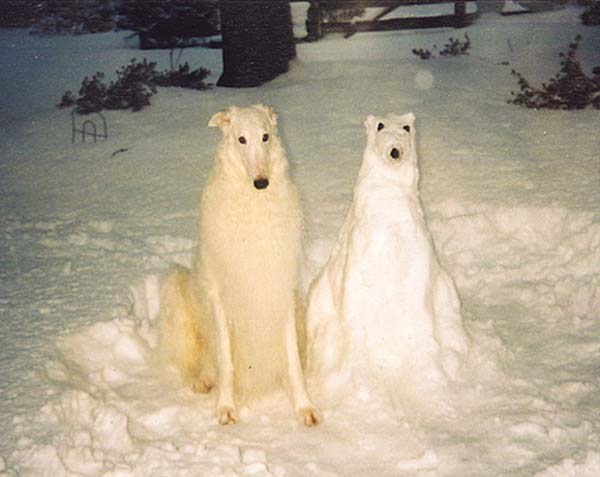animals
‘The sexual act is in time what the tiger is in space.’ –Georges Bataille

A neurologist and other scientists argue animals are capable of having spiritual experiences.
The researchers hold that spiritual experiences originate within primitive parts of the human brain, structures shared by animals.
The challenge lies in proving what animals experience. (…)
A Neurology journal study, for example, determined that out-of-body experiences in humans are likely caused by the brain’s arousal system, which regulates different states of consciousness.
“In humans, we know that if we disrupt the (brain) region where vision, sense of motion, orientation in the Earth’s gravitational field, and knowing the position of our body all come together, then out-of-body experiences can be caused literally by the flip of a switch,” he said. “There is absolutely no reason to believe it is any different for a dog, cat, or primate’s brain.”
Other mammals also probably have near-death experiences comparable to those reported by certain humans, he believes.
Boys will be boys and our two twins were no exception to this golden rule

{ 1. unsourced | 2. Ignas Kozlovas }
But just then there was a slight altercation between Master Tommy and Master Jacky

{ 1. Joseph Jastrow’s Duck-Rabbit, 1899, based on drawing published in German humor magazine Fliegende Blatter, 1892 | 2. Taxidermed rabbit–duck | via Richard Wiseman }
I noticed a depiction of the famous “duck-rabbit” figure, described as an “illusion” and attributed to Wittgenstein (Malach, Levy, & Hasson, 2002).
Technically, the duck-rabbit figure is an ambiguous (or reversible, or bistable) figure, not an illusion (Peterson, Kihlstrom, Rose, & Glisky, 1992). The two classes of perceptual phenomena have quite different theoretical implications. From a constructivist point of view, many illusions illustrate the role of unconscious inferences in perception, while the ambiguous figures illustrate the role of expectations, world-knowledge, and the direction of attention (Long & Toppino, 2004).For example, children tested on Easter Sunday are more likely to see the figure as a rabbit; if tested on a Sunday in October, they tend to see it as a duck or similar bird (Brugger & Brugger, 1993).
But the more important point of this letter concerns attribution: the duck-rabbit was “originally noted” not by Wittgenstein, but rather by the American psychologist Joseph Jastrow in 1899.
Which gave that haunting expression to the eyes
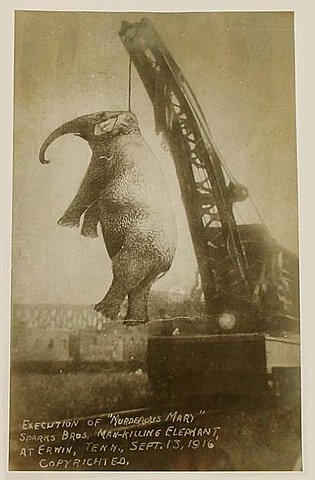
{ The townspeople demanded that Mary be killed. Debates on how to kill Mary ensued. It was determined that no gun existed big enough to take her down. Electrocution and canons were other proposed methods. Finally, it was decided that Mary would be hung from a rail yard crane in the nearby town of Erwin, Tennessee. | Keep my words | Continue reading }
related { Squirrels refuse medical care }
bonus:

Hypnosisss can cure you of your psssychosssis

Nobody asked me, but the building was designed for the Astor Estate by Herman Lee Meader, a Harvard-trained architect who gave legendary parties and kept a boa in his penthouse.
{ Christopher Gray | Photo: Ray Sawhill }
Herman Lee Meader (died February 14, 1930 at 55) was an American architect and author. He designed several prominent buildings in Manhattan, both commercial and residential, as well as much work on the Astor estate, including the Waldorf building located at 8 west 33rd St., then the heart of the fashionable shopping district. Meader lived in the Waldorf Building penthouse, where he created a surrounding rooftop Italian garden. There he held elaborate parties which attracted musicians, artists, writers, prizefighters, chess players and others—at one, Meader staged a fight between a black snake and a king snake.
bonus [click to enlarge]:
{ NY Times }
Kod knows. Anything ruind. Meetingless.

Is it Easy to be an Urban New York Ant?
If scientists learn how critters adapt to difficult-to-colonize locations (especially ants, which colonize just about every available habitat, and are able to make quick decisions), they will be more likely to learn how to maintain biodiversity in more readily habitable locations.
With this goal in mind, Marko Pecarevic and coworkers have studied ant life on street medians in New York City.
Why study ant life on street medians?
Current hypotheses state that wider street medians should host more species. This is an extrapolation from analogous studies in natural environments.
However, there’s good reason to suspect that unique features of urban life may result in different ecological adaptations. Human disturbance, for example, may be more prevalent on wider street medians, disrupting the local urban ecology.
Furthermore, it’s possible that ants treat street medians either as habitable islands (surrounded by inhabitable pavement), or a connecting patchwork linking more habitable environments (e.g. plants in sidewalk cracks). These are the kinds of questions probed by Pecarevic and coworkers.
The scientists sampled ants from 44 street medians in New York City in July 2006. (…) The scientists collected over 6600 ants from 13 species and 11 genera (the next highest classification above species). Ninety-four percent of the ants were from one of three species. The first is non-native, and the latter two are native.
photo { Sotheby’s Divine Comedy billboard featuring Maurizio Cattelan, Him, 2001 + cab door, 10 Ave, between W 28th and W 29th st, Thursday, October 7, 2010 }
Witnessing a horse being whipped by a coachman at the Piazza Carlo Alberto, Nietzsche threw his arms around the horse’s neck and collapsed

Horses have become so devalued in Dublin they have been swapped for a mobile phone or purchased for as little as €15, an Oireachtas committee was told yesterday.
The Committee on Agriculture, Fisheries and Food was also told welfare problems in the capital included animals being starved, ridden to exhaustion, beaten, slashed, rammed by cars and set alight.
Dublin City Council deputy city manager Philip Maguire said there were only 30 licensed horses in Dublin, mainly carriage horses, but there were hundreds of unidentified horses in the city.
‘Compassion for animals is intimately connected with goodness of character, and it may be confidently asserted that he who is cruel to animals cannot be a good man.’ –Schopenhauer
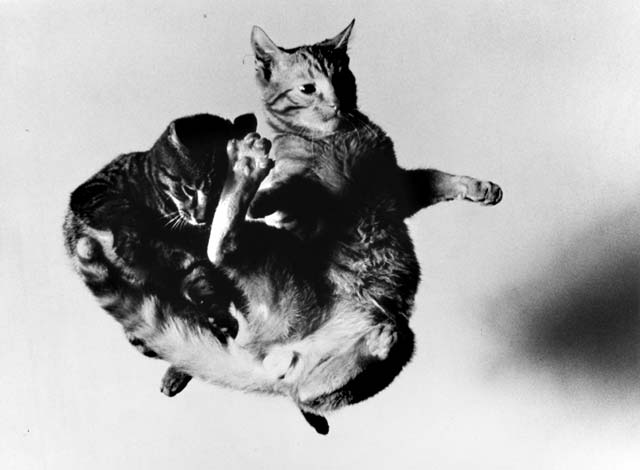
Babies can readily differentiate pet dogs and cats from “life-like” battery-operated toy dogs and cats. Babies will smile at, hold, follow, and make sounds in response to the live animals more than in response to the toys. In one study, 9 month olds were more interested in a live rabbit than an adult female stranger or a wooden turtle. A 1989 study of 2- to 6-year-olds with animals in their classrooms showed that children ignored realistic stuffed animals (80% never looked at them), but that live animals - especially dogs and birds - captured the attention of the children. Seventy-four percent touched the dog, 21% kissed the dog, and more than 66% talked to the bird.
Living with pets seems to stimulate children’s learning about basic biology. In one study, Japanese researchers showed that kindergarteners who had cared for pet goldfish better understood unobservable biological traits of their goldfish, and gave more accurate answers to questions like “does a goldfish have a heart?” (…)
When asked to name the 10 most important individuals in their lives, 7- and 10-year-olds on average included 2 pets.
A smile that verged on tears, and then they parted
Over the last century, 98pc of the world’s tiger population has been wiped out, first by big game hunters, and latterly by poachers, who kill these magnificent creatures and hack them to pieces.
And for what? Well, money, for one thing. The rarer tigers become, the more valuable they are to the poachers, who sell their bones and organs on the black market for traditional Chinese medicines. (…) which is said to have aphrodisiac qualities. (…)
Scientific studies have shown that the claims made for tiger penises are, if you’ll pardon the expression, bollocks. But so far that’s failed to prevent the carnage escalating.
There are only a few thousand tigers left in the wild. They could well disappear off the face of the planet within 10 years.
‘So long as you have food in your mouth, you have solved all questions for the time being.’ –Kafka
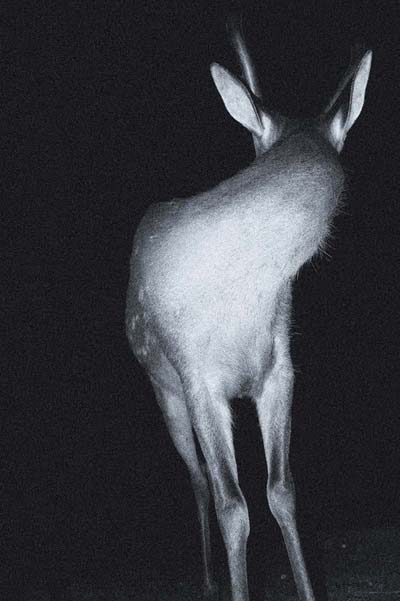
So what does fascinate me in the animal? The first thing that fascinated me is that every animal has a world. It is curious because many people do not have a world. They live the life of everyone’s life, no matter who, no matter what. Animals have worlds. An animal world, what is it? It is sometimes extraordinary limited. And this is it that moves me. Finally the animals react to very few things. Several sorts of things.
(…)
So the very first characteristic of the animal is the existence of specific, peculiar animal worlds; and it is perhaps, sometimes, the poverty of those worlds, the reduced character of those worlds that interest me a lot.
For example, we have been previously talking about animals such as the tick. The tick responds or reacts to three things. Three stimuli. Nothing more in a nature that is a huge nature, three stimuli, that’s all. It tends towards the edge of a branch, attracted by light. It can wait on top of that branch for years without eating, without anything, totally amorphous. Well, it waits for a ruminant, an herbivore, an animal that passes under its branch, ready to drop; it is a kind of an olfactory stimulus. The tick smells the animal passing under its branch. The second stimulus; the light then the smell. Then, once fallen on the back of the poor animal, it will look for the least hairy area. Here a tactile stimulus. And it sinks into the skin. It does not care about anything else. In a swarming nature, the tick extracts three things. This is what makes a world.
(…)
It is not enough to have a world to be an animal. What absolutely fascinated me are the issues of territory. Because constituting a territory is nearly the birth of art.
(…)
If someone would ask me what an animal is, I would answer “a being on the lookout”. It is a being fundamentally on the lookout. (…) The writer is on the lookout. So is the philosopher. You see, the ears of an animal. Well it does nothing without being on the watch. An animal never keeps still. While eating, it has to watch out if anything is happening in its back, on its sides, etc. Such an existence on the lookout is terrible.
{ Gilles Deleuze’s ABC Primer, with Claire Parnet | PDF | Read more | Video 1, Video 2 }
photo { unsourced }
‘Recognize meat for what it really is: the antibiotic and pesticide laden corpse of a tortured animal.’ –Ingrid Newkirk, PETA President
On May 15, 1985, trainers at Hawaii Sea Life Park were stunned when a 400- pound gray female bottlenose dolphin named Punahele gave birth to a dark-skinned calf that partly resembled the 2,000-pound male false killer whale with whom she shared a pool. The calf was a wholphin, a hybrid that was intermediate to its parents in some characteristics, like having 66 teeth compared with the bottlenose’s 88 and the 44 of the false killer whale, a much larger member of the dolphin family. (…)
While several examples of human-bred animal hybrids are well known and can thrive in captivity including zorses (zebra-horse), beefalo (bison-beef cattle) and, of course, mules (donkey-horse), naturally occurring animal hybrids have many factors working against their longer-term success.
They don’t seem to chew it; only swallow it down.

{ “A real piglet that has been taxidermied and inserted with what all piglets probably dream of as babies, a coin storage unit and a cork plug.” | $4,000 | thecheeky.com }
Shout a few flying syllables as they pass
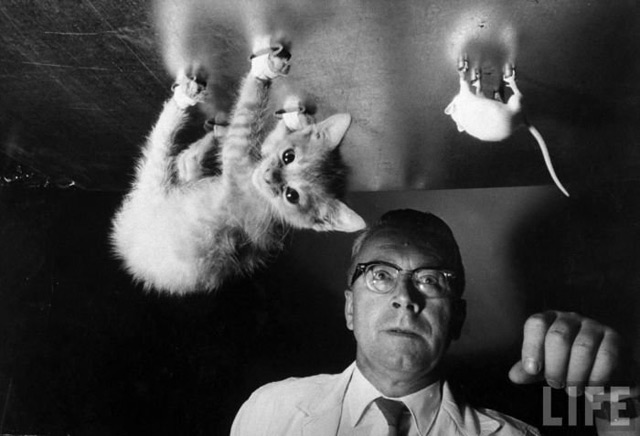
When police in Western New York pulled over Gary Korkuc for blowing off a stop sign on Sunday, they found a live cat in his trunk, covered in cooking oil, peppers, and salt. Korkuc told authorities that his pet feline was “possessive, greedy, and wasteful” and that he intended to cook and eat it. Korkuc has been charged with animal cruelty. Is there a legal way to cook and eat a cat?











